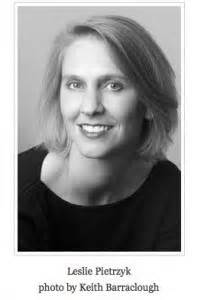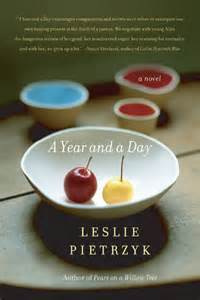A GUEST BLOG FROM LESLIE PIETRZYK
 “She smiled, he laughed, and their eyes met.” Sounds delightful, especially if one of those two is you and you’re in the mood for love (swapping out pronouns as necessary, of course). If, however, any of this resembles sentences in your work-in-progress, then it’s time for an intervention.
“She smiled, he laughed, and their eyes met.” Sounds delightful, especially if one of those two is you and you’re in the mood for love (swapping out pronouns as necessary, of course). If, however, any of this resembles sentences in your work-in-progress, then it’s time for an intervention.
There’s nothing wrong with smiling. I do it myself now and then. And I even laugh in my real life. Let’s hope we all do. But I’m struck by how often characters in beginning writing smile and laugh when there are a zillion more interesting gestures or sounds the writer could choose to convey the same emotional state of mind.
I lump this annoying smiling and laughing under the broad category of “writing tics.” Many beginning and established writers don’t realize how often they rely on certain words and phrases. We all know that writing is hard work, and so when our brain finds a shortcut, it tends to stick with it. Someone’s happy: let them laugh! Two characters first meet: how about a smile? Reaching beyond the obvious takes thought and makes our heads hurt: the happy character who twirls in a charming and precisely described pirouette. Is pirouette too corny? Does her skirt flip up or swoop out; like a bell is a cliché, so what’s another shape? What color is that skirt; is there lace on it? No wonder we simply want to slip by with a laugh.
Smiling (and its kissing cousin, the grin) and laughing (along chuckling, a sound I’m convinced doesn’t exist in real life) are two of the most universal writing tics, but there are others:
Eyes: meeting, locking, cutting, glancing, watching
Sighs: deep, gusty, forlorn, heavy
Crying: tears slipping and sliding down cheeks, hovering along eyelashes, spilling and rolling
Hearts: pounding, thumping, racing
I suspect we can blame movies and TV with their close-ups for the preponderance of written character descriptions that revolve around eyes—their color, their intensity, their shiftiness. Hair color is also up there. Certainly we notice hair in real life—but there’s much more beyond the color. Length? Texture? Style? Don’t tell us “blonde hair”; tell us the story of who your character is with a description of what’s unique about this blonde hair. And, honestly, in real life, how often are we noticing the “milky blue” eyes of the cashier at the grocery store? Do we really look at the parent in the carpool line and think, “Hmm…coffee-colored eyes like shimmering pools”? I scarcely notice other people’s eyes in my daily life, and consequently I suggest that characters should tone down their laser-like focus on what everyone else’s eyes look like. (Exceptions made for characters who are optometrists, of course.)
It’s tempting to think that writing tics are exclusive to the beginner, but every writer carries the baggage of beloved shortcuts. For many years, my characters were the kings and queens of the “gusty sigh,” usually while staring out a window with a pane that was often “lined with drizzle.” Way too many of my characters “shifted their weight from side to side” when they were anxiously standing around somewhere, especially as “rain drummed the roof.” And my characters should have been a little more ripped for all the times they “folded and unfolded their arms against their chests” as their mouths “tightened into a hard, straight line.”
Story after story, chapter after chapter—fists clench, jaws tighten, eyebrows are either raised or arched, lips are bitten, deep breaths are drawn in, and tension stretches like a rubber band…. And it’s not just clichés and familiar, generic phrases like the ones I’ve cited; often we return to beloved images, inserting them into our work again and again without even realizing we’re doing so. For a long while, I was big on finding any excuse for my characters to blow the seeds off dandelions, and I’m still not immune to various variations on stones in water and ripples radiating along ponds. We’re susceptible to our favorite words: I endlessly have to delete the word “faux”; despite how beautiful the word looks on the page (or screen), one use per every third short story is ample. (But see how deftly I was able to work it into this piece!) And, actually, I endlessly have to delete “endlessly,” too…another favorite.
A writing tic that will have to be pried out of my cold dead hands is my use of food. My characters eat A LOT. When I don’t know what to do with them, I send them to the kitchen, the dining room table, or a restaurant. It happens that I love to eat and cook, so yes, I want to write about something I enjoy—but it’s a writing tic. I’m not sure I’ve ever written a story where no one eats. If a Martian landed on Earth and read any random 500 pages of my writing, it would assume that Earthlings were obsessed with food. That Martian might also note an overuse of the word “tines” as people fiddle with their utensils a bit too often, in another writing tic of mine.
Rosecrans Baldwin wrote in Slate about the overuse of these phrases: “somewhere a dog barked” and “a dog barks in a distance,” discovering instances in writers as varied as Woolf, Eggers, Vonnegut, Faulkner, and Stephen King. As for me…guilty! I don’t even especially like dogs, yet they often bark in my fiction on a dark night. It’s easy to see why this phrase feels promising to the writing brain: the pleasing sensory sound of a dog, the detail providing a pause in action to let tension mount, the writer’s sense that a barking dog is conceivable in most neighborhoods. One barking dog is interesting, but this pack of yappers surely is a writing tic.
The reason I’m opposed to writing tics—with the exception of my fascination with characters eating—is that the tic is the familiar. It’s the first word/phrase/image our brain comes up with, so surely it’s the least interesting. It’s too easy. What would we discover if we forced ourselves to keep thinking? These tics of ours are bland and comfortable. While vigorous writing can appear easy on the page, I want my work to create discomfort in the reader and the writer. I want angles in my words and images, not soft, smooth edges. Or, to retreat into imagery I’m comfortable with: there’s only so much vanilla pudding a reader can spoon down before hoping for a plate of fiery, New Mexican red chile enchiladas.
I first learned that my characters sighed too much when a helpful teacher circled each and every sigh with his wrathful red pen. If you don’t have that sort of helpful teacher in your life, you can word search your document to see how often eyes show up or smiles or whatever words you think you’re susceptible to. I suggest putting several stories into one large file and doing the search, to show a larger pattern. Or take some time and simply read many stories and/or chapters all in one swoop; maybe ask a careful friend to help. Read slowly, and try to focus not on editing, but on the words. You’ll probably get better results if you print out your work on real paper, changing to a font you don’t normally use: there’s nothing like the rigidity of Courier to add a bracing splash of cold water to the process.
I’m not sure how helpful this next bit of advice is, but it’s fun: put your novel (or several short stories) into a word cloud and see which words loom largest in the resulting picture. The reason this strategy might not be helpful is that often the character’s names are gigantic, meaning they’re used the most, which makes sense. But the reason this strategy might be VERY helpful is because of what I learned when I recently created several work clouds using a novel-in-progress, an unpublished novel manuscript, and an older collection of stories that never appeared as a collection. Here are the results:
Novel-in-progress: Character names, and then the words, one, like, back
Unpublished novel: Character names, and then the words, one, baby, man, back
Old collection of stories: Character names, and then the words, one, like, didn’t
 The persistence of “one” and “like” was surprising, so I tested out the last ten or so entries on my blog where there would be no character names, and the biggest word was… “one.” Such results leave one feeling slightly convinced, no? Here’s the site that creates word clouds: http://www.wordle.net/
The persistence of “one” and “like” was surprising, so I tested out the last ten or so entries on my blog where there would be no character names, and the biggest word was… “one.” Such results leave one feeling slightly convinced, no? Here’s the site that creates word clouds: http://www.wordle.net/
Don’t hyper-panic right now and struggle for three days about how to convey a character’s pleasure. In draft, sometimes you just have to write “she smiled.” At least I do. Revision is the time to think about tics and review work with the harsher, editor’s eye. Smile and laugh away in that first draft; hearts can pound if later in the process they rattle in the ribcage like a rock in a sieve.
And my final bit of advice is to remember that every writing rule can be broken. Flannery O’Connor often noted her characters’ eyes, so much so that a brave person might suggest that was one of her writing tics. But how those eyes were described!
“The child looked at him with a kind of half attention, his eyes forward but not yet engaged. They were a paler blue than his father’s as if they might have faded like the shirt; one of them listed, almost imperceptibly, toward the outer rim.”
~”The Lame Shall Enter First”
“Only his left eye, twisted inward, seemed to harbor his former personality. It burned with rage. The rest of his face was prepared for death.”
~”Why Do the Heathen Rage?”
“The skin on her face was thin and drawn as tight as the skin on an onion and her eyes were gray and sharp like the points of two icepicks.”
~”Parker’s Back”
All we have to do is that.
****
Leslie Pietrzyk is the author of two novels, Pears on a Willow Tree and A Year and a Day. Her short fiction has appeared in many journals, including Shenandoah, Gettysburg Review, Iowa Review, The Sun, and River Styx. She edits the online journal Redux, blogs at Work in Progress, and teaches fiction in the Converse College low-residency MFA program and the graduate writing program at Johns Hopkins University. For more information: www.lesliepietrzyk.blogspot.com

